
Comic Book Historians
As featured on LEGO.com, Marvel.com, Slugfest, NPR, Wall Street Journal and the Today Show, host & series producer Alex Grand, author of the best seller, Understanding Superhero Comic Books (with various co-hosts Bill Field, David Armstrong, N. Scott Robinson, Ph.D., Jim Thompson) and guests engage in a Journalistic Comic Book Historical discussion between professionals, historians and scholars in determining what happened and when in comics, from strips and pulps to the platinum age comic book, through golden, silver, bronze and then toward modern
Support us at https://www.patreon.com/comicbookhistorians.
Read Alex Grand's Understanding Superhero Comic Books published by McFarland & Company here at: https://a.co/d/2PlsODN
Series directed, produced & edited by Alex Grand
All episodes ©Comic Book Historians LLC.
Comic Book Historians
All Star 3: Anthony Tollin, Whilce Portacio, Jimmie Robinson, Benton Jew, & Jim Cheung with Alex Grand.
Alex Grand goes to San Diego Comic Con 2019 and interviews Anthony Tollin, Whilce Portacio, Jimmie Robinson, Benton Jew, and Jim Cheung for an All Star CBH Podcast special.
Anthony Tollin was a prolific comic colorist influenced by comics from the Golden and Silver Age, who started working at DC Comics in the early 1970s discussing his influences and co-workers like Sol Harrison, Irv Novick, Jack Adler, Jim Aparo, Bob Oksner, Walter Gibson, Lee Falk, Jack Kirby, Joe Simon, George Perez and John Byrne. He also discusses his involvement in Pulp history with the Shadow and Radio involvement with the Lone Ranger. While Portacio, comic artist influenced by Neal Adams, Jack Kirby and Alex Nino, grew up on a variety of genres in comic books especially fantasy and sci fi, got his start at Marvel inking projects like Longshot in 1985, discovered by Carl Potts and worked on titles like Punisher, X-Men and X-Factor before moving to Image Comics in the 90s. Jimmie Robinson, comic artist who grew up on a variety of genres in comic books, inspired by Neal Adams, got his start in independent comics, discovered by Jim Valentino and created Bomb Queen for Image Comics. Benton Jew, comic artist and story board artist who has worked on various characters like She Hulk, Wolverine, Agents of Atlas, Venom, Wonder Woman and independents like Monster Verse. Jim Cheung, comic artist for the 90s who was artist for variety of superhero teams like Force Works, X-Force, Avengers, and DC's Justice League. Edited & Produced by Alex Grand. Sound FX - Standard License. Images used in artwork ©Their Respective Copyright holders, images used for academic purpose only.
Alex Grand: Well, I’m Alex Grand… I’m speaking to comic book and pulp historian, veteran Anthony Tollin. Anthony Tollin, how are you doing?
Anthony Tollin: I’m doing just fine.
Alex Grand: Anthony tell us about what kind of comics you were reading as a child and what got you into comic books?
Anthony Tollin: Well, the first comic book I bought was Superman with the rainbow powers and I think 1958

, and my favorite comic book in my childhood was Green Lantern, because I was the child of the space age. John Glenn went into orbit on my 10th birthday, and Hal Jordan of course was a Chuck Yeager-esque test pilot.
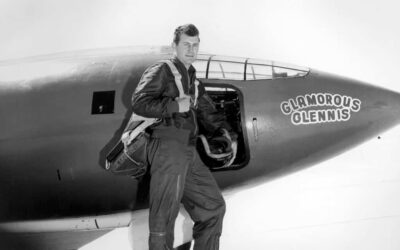
Anthony Tollin: By the way today, 50 years ago today, I watched Neil Armstrong set foot on the moon, with Gordon Dickson, who was that year president of the Science Fiction Writers of America.
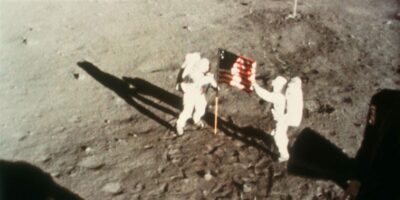
So the day that science fiction became science fact, I was sharing the event with the president of the SFWA, and one of the great science fiction writers himself. But my favorite characters have always been the Hal Jordan Green Lantern although I cosplayed as Alan Scott at the 1973 Seuling-Con.
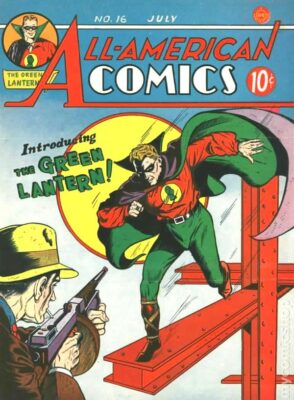
Alex Grand: Powered by the green flame.
Anthony Tollin: Right. And The Shadow
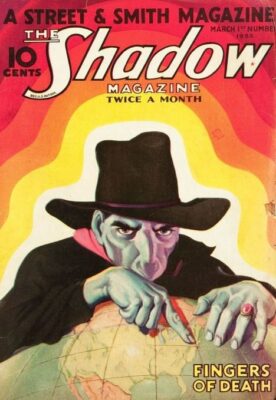
I fell in love with in junior high and I started collecting the pulps, I have a complete set of The Shadow pulps, and I co-authored The Shadow Scrapbook with Walter Gibson.
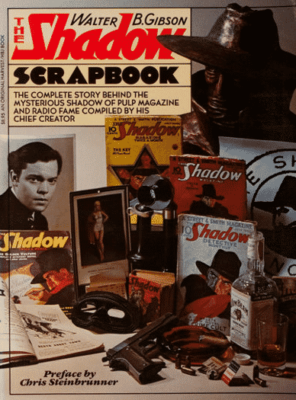
And the other one of my top favorite characters is The Phantom, and I was a friend of Lee Falk’s. And The Phantom of course predated Superman by two years and predated Batman’s debut by three years, debuted in February of 1936, but I was really lucky I got into comic books as part of the group that Howard Chaykin refers to as being there at the end of the beginning.
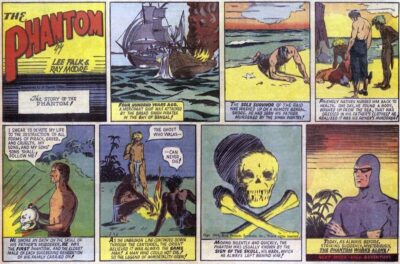
Anthony Tollin: And we were there at the end of the beginning because people hired us and the people trained us and the people we worked with were there at the beginning of comics. My two immediate bosses, Jack Adler, Jack did the color separations and coloring on Prince Valiant in 1937-38 on the Sunday pages for Hal Foster.
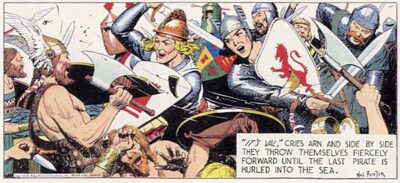
And, he developed the color separation method by which most comics were separated up to the digital computer age. And Jack also, like Sol Harrison, worked on Action Comics #1 on the separations.
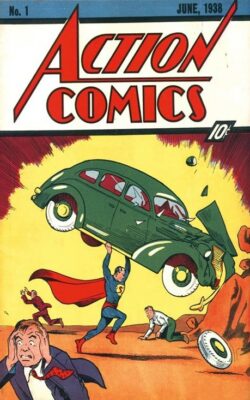
And Sol actually worked on the separations and operated the binding machine on Famous Funnies #1, the first comic book in 1934.
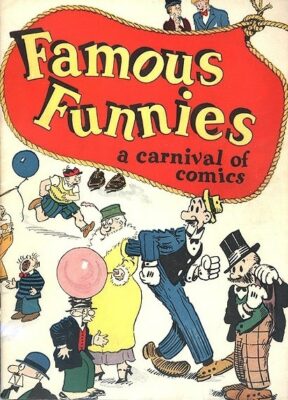
So it’s really those of us who were members of the DC Woodchucks, who were working for DC in ’74,’75 through the seventies who have a lot of the memories we are preserving of the stories that the people who were there at the very beginning told us.
Alex Grand: And this is the genesis of comic books, and you mentioned Lee Falk. You’ve also mentioned before Walter Gibson and these both created characters that would influence Batman and the characters we know now.
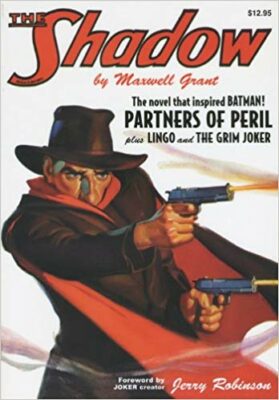
Anthony Tollin: The very first Batman comic book story, The Case of the Chemical Syndicate was lifted start to finish from a 1936 Shadow novel Partners of Peril, which curiously was the first Shadow novel not written by Walter Gibson, but perhaps because of a simpler plot with less intricacies it was easier to adapt to a six page comic book story. But Bill Finger said that his first Batman story was a take-off on a Shadow novel. It was far more than a take-off.
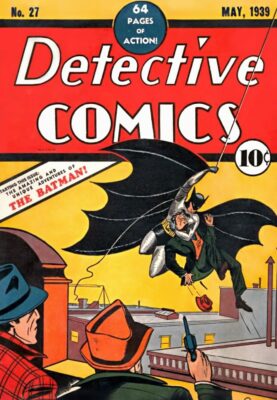
There is nothing in that first Batman story other than the name and the costume that was not lifted from the Shadow novel. And in fact, The Shadow in the course of that novel is referred to several times as bat-like or a living bat, but yet Walter was one of the giants in comics. Walter Gibson also worked for 25 different comic book companies, Ace, Avon. He created Space Western for Charlton.
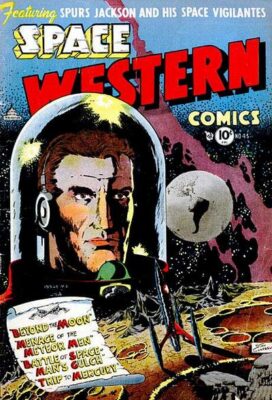
He wrote Captain Marvel family, and

Bulletman stories for Fawcett.
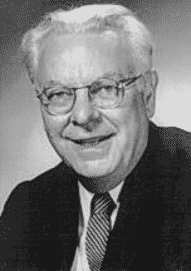
So I mean Walter, I keep recommending Walter for the Bill Finger Award because while he was a famous writer, his comic book work was generally unknown. He wrote most of The Shadow comic book stories in The Golden Age. He wrote a Bill Barnes story in which American pilot Bill Barnes is sent to end the war with Japan by dropping a U-235 bomb on Japan and the story came out in the spring of 1942 less than six months after Pearl Harbor and three years before Hiroshima and the U.S. government was not happy.
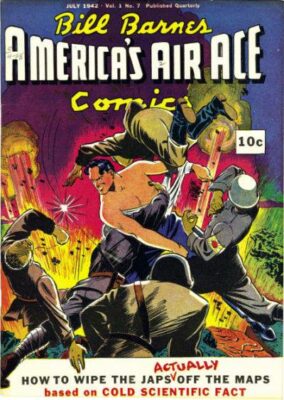
G-Men arrived at the Street and Smith offices because they just started The Manhattan Project, and suddenly here’s a story that says on the cover, in this issue we demonstrate with cold scientific facts how to blow Japan into the ocean, and there was quite a bit of explanation as to how a U-235 bomb would work and how powerful it would be and as I said, it came out four years before the atomic bomb.
Anthony Tollin: But I was of the generation of young fans and it’s funny to realize that the old guys, and it was so clear because there had been virtually no one new in the business since the forties except for a few during the EC.
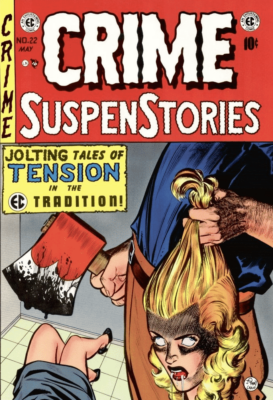
Early fifties with EC, but because of the retrenchment that happened during the post Comics Code era,
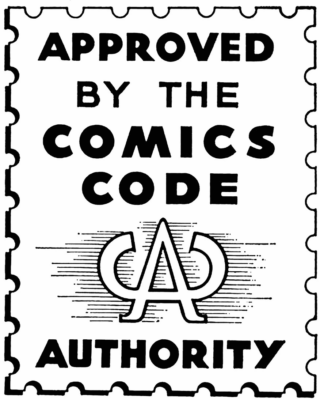
no one new would come into the business until you had a couple like Roy Thomas and Neal Adams

and Jim Steranko in the mid sixties,

but then a few years later you had Len Wein and Marv Wolfman and Bernie Wrightson
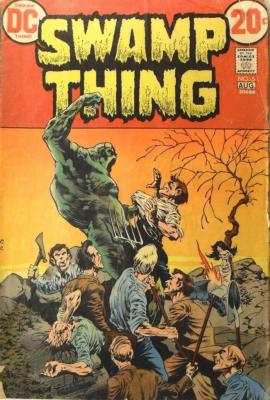
and Mike Kaluta,
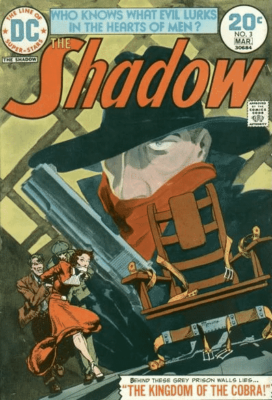
Howard Chaykin,
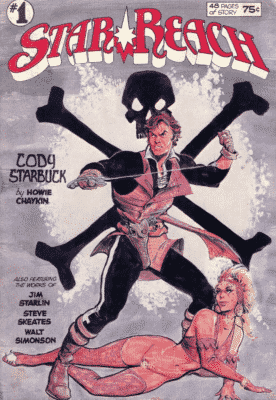
our generation, and Tony Isabella.
Anthony Tollin: I started at Warren and Marvel in ’73. I worked on Famous Monsters #100, and went to DC and began 21 years at DC Comics in ’74,
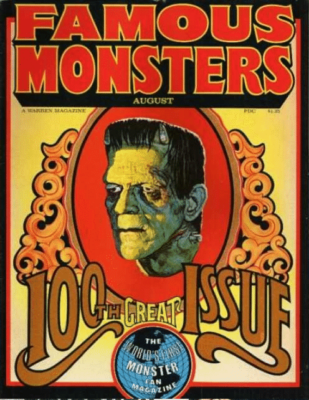
and we were there to work with the people. I mean, Bob Oksner and Irv Novick had both started in comics in 1939. Irv Novick was the original artist on The Shield at MLJ,
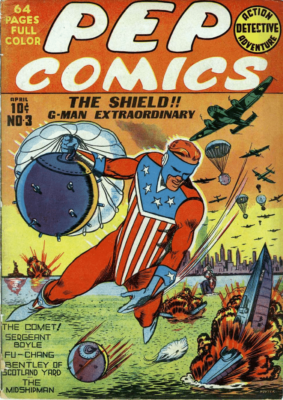
and he was drawing Batman when Adrienne and I were coloring it in the late seventies.

Alex Grand: The Adrienne you’re referring to your wife?
Anthony Tollin: My late wife, Adrienne Roy,
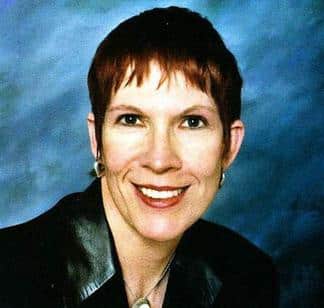
who colored 202 issues of detective comics, 191 issues of Batman, the Wolfman, Pérez Teen Titan from the beginning, Mike Grell’s Warlord starting with number 11.

She colored Crisis on Infinite Earths with me.
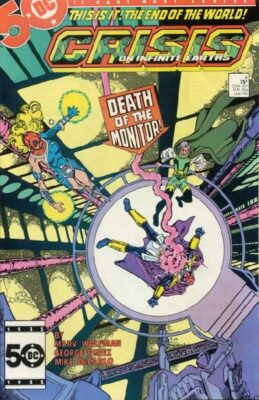
Actually because of deadlines would reach the point where almost everything we did was done as a team. I tended to do The Shadow Strikes and The Phantom by myself, she did Manhunter and some of the Batman stories, and Slash Maraud she did on her own, but generally I would do the covers and then we would work together. It was just because so many of the hot books we were on had the most overworked teams, so they were coming in and had to be colored in two days or something. So the two of us would team up and…
Alex Grand: Knock out a lot of pages.
Anthony Tollin: Yeah. I often have noted that a lot of people who were fans then thought Adrienne Roy colored every comic at DC and that wasn’t the case. She was actually only coloring the titles that people were reading.
Alex Grand: Yeah, and I think a lot of people look back at those issues, maybe at the time they just said, “Okay, this is a fun comic,” but looking back that coloring that you guys did was really special.
Anthony Tollin: Well, basically a colorist does basically in a comic book the work that a cinematographer does in a movie. I only recently learned a few years ago, Jim Steranko told me what a cinematographer does. And they never touch the camera. They light the scene. And it’s a colorist’s job to focus the attention on what’s important to kill what’s unimportant, and basically through that tell the story. In the real world you see a lot of bright fire engine red chairs, comfy chairs and such, but if you had that in a comic book story it would direct your attention away from what was important. So you shouldn’t have a bright red chair in a comic book story unless there’s 10 million dollars hidden in it and it’s important for some reason. But they said I was lucky to be trained by Jack Adler and Sol Harrison.
to work with Julie Schwartz and Murray Boltinoff who had been there since the early forties.
Alex Grand: Titans of the industry for sure.
Anthony Tollin: Yes, and the living history of the business and Sol,
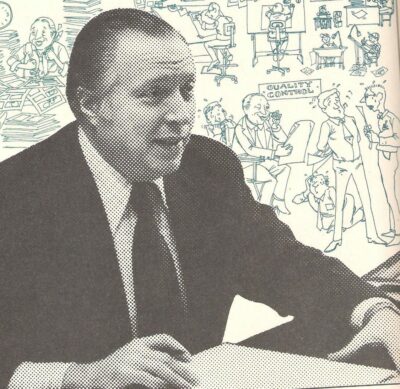
they said it was Sol who recognized that they were all in their mid to late fifties and that since they cared about the company, they needed to start training their successors. Kind of a sobering thought to realize that at the time, Sol Harrison and Jack Adler were a decade younger than I am now.
Alex Grand: And they felt like old men back then.
Anthony Tollin: Oh they’d been there. One of the amazing things about Paul Levitz. Paul Levitz started as an assistant editor at DC in 1973. 1973, Superman had been published for 35 years. 1973 is now 46 years ago. So Paul Levitz has been at DC for close to two-thirds of the history, of publishing history of Superman. Well over half the history of Superman, Paul Levitz has been there.
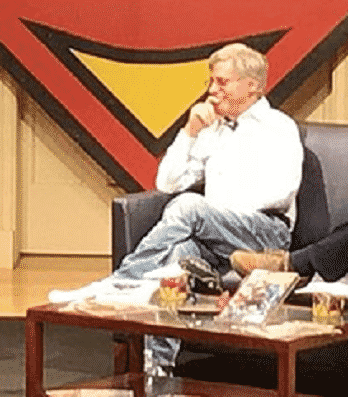
Anthony Tollin: And that’s one of the things we were very fortunate at DC. When I read a history of Marvel Comics during the sixties and seventies and eighties, Marvel went through so many changes of ownership and so many regime changes. Whereas DC, it was pretty consistent. You had, after Carmine was let go in the beginning of ’76 you had Sol and Jenette for five or six years, and then you had Jenette Kahn as president for,
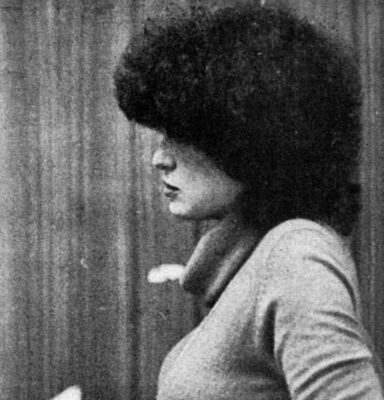
Paul Levitz as publisher. Paul was publisher for 22 years and president and publisher for seven years I believe. And so we had a consistent leadership and consistent direction and it wasn’t changing at the whim of whoever was the head of the month. And so I’m really happy I had those years at DC.
Anthony Tollin: I regret that my comic book career ended when I developed gray hair, but I would never trade the years I had at DC. I wish my DC career was longer, but I wish it was longer at the early end, when you were working with the Julie Schwartz’s and the Murray Boltinoffs and Joe Kubert.

Anthony Tollin: Oh when I started at DC, Joe Simon was part-time manager at DC, the creator of Captain America. He was doing Sandman and Green Team and he was editing Young Romance and Young Love.
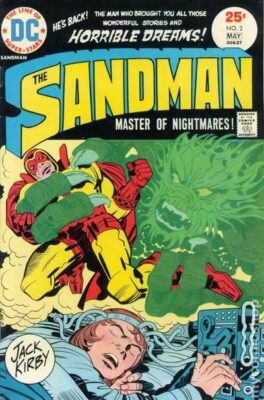
So I mean, and he and Kirby had created the love… We think of them for Captain America and Boy Commando, but they created the first horror comic Black Magic.
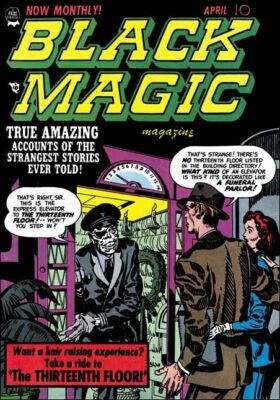
They created the first romance comics, Young Romance and Young Love.

Anthony Tollin: A friend of mine and I, Rick Norwood, who publishes Comics Revue, the newspapers strip thing, used to when we were living nearby, challenge each other to have one of us name major comic book characters created by Jack Kirby, and the other major comic book characters created by everyone else. And it was generally a toss up as to who ran out of names first. And the same thing, major villains created by Jack Kirby, major villains created by everyone else in comics, and you just realize, and I got to color Jack Kirby in New Gods, which is just fabulous.
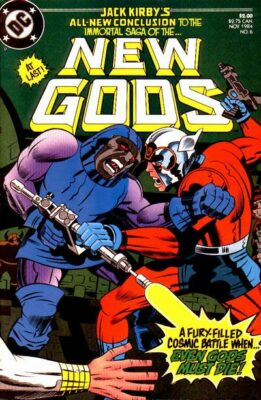
And I colored Gil Kane and Dave Gibbons on Green Lantern. I colored George Pérez on Crisis on Infinite Earths, and I colored half the covers at DC for about a decade, with the other covers being colored by Tatjana Wood, Wally Wood’s ex-wife.
Anthony Tollin: It was just a great time, and the great thing about comics when I got into it in 1973 and ’74, well when I started at DC in ’74, there were 33 people on staff, sometimes 35, but generally 33 to 35 people on staff, including the payroll department upstairs. So there were generally like 27 of us in editorial production, the executive ranks, the dark room and the overseas export department. So everybody knew everybody in the comic industry. Kaluta and Geoff Jones and Barry Smith’s art studio, or at Neal and Jenette’s first Fridays.
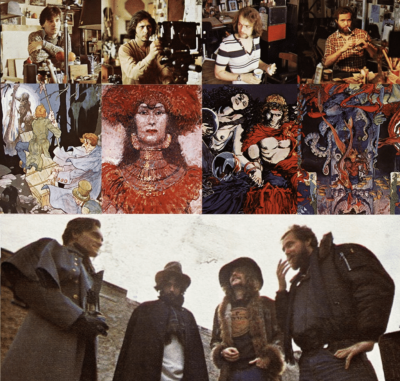
Anthony Tollin: It was a very different business because you didn’t have FedEx then. So everyone had to live in the New York area, so we all knew everybody.
Alex Grand: That’s interesting. Yeah, the FedEx really makes a difference because now everyone’s all hanging out with each other.
Anthony Tollin: Right, but back then most of us had moved in from out of town. There were people like Howard Chaykin who’d gone, and Steve Mitchell and Alan Kupperberg were local, Marv Wolfman and Len Wein, but most of us, I came from Minneapolis, Tony Isabella from Cleveland, Tom Orzechowski a lot from Detroit, Al Milgrom and Jim Starlin and Rich Buckler were from Detroit. Bill DuBay who I worked with at Warren was from California. Ao we really didn’t know anyone other than each other. And so we were really in a like a literary, Parisian literary communities of 1920s. We were a community in a way that comics has not been since then. There’s a special excitement one has, when you’re young and in your dream job and just learning so much every day, and that’s why people like Jerry Robinson would so fondly remember the early days of The Golden Age, and the people work for them.
Advertisement
Alex Grand: They were creating the language back then.
Anthony Tollin: Right but we were there as I said, at the end of the beginning. And we were there right in the transition when our new generation people like George Pérez and John Byrne and…
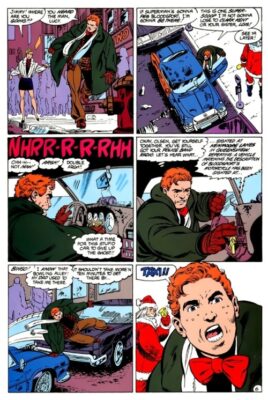
John Byrne had to change his signature because he had a strange signature starting out and people kept reading it as Tollin. John told me that he had to change his signature because people kept thinking it was my work. He had a J that looked kind of like a T and an N at the end and this scrawl in between, but Walt Simonson and you had all these people starting to change things and also coming from a tradition where they had not grown up in the pulp era and the depression, so they were a bit more willing to demand. The people who grew up in the depression were fearful of losing jobs. Well we were right there when things were really changing, so we had the excitement of working with the people who had been there from the beginning, but we also had our new generation coming in and taking over.
Anthony Tollin: Only recently have I really come to appreciate that period, because when I first started at DC, was just after the period when we got all this creativity with Bat Lash and Anthro and Deadman and Green Lantern and Green Arrow, and they hadn’t appeared to have sold that well, so there was an attitude, well, quality doesn’t sell, so why bother.
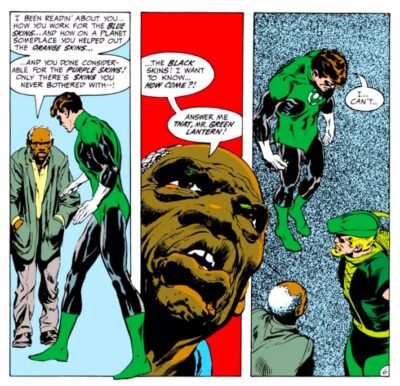
We still had Swamp Thing. We had the Kaluta Shadow, but when I look back and just realized a few years later, New Teen Titans, Don Newton on Batman and Jim Aparo and once again Swamp Thing and Mike Grell’s Warlord, which my wife Adrienne colored.

We had a major… And I see someone with a 3D model of a cover I colored right behind you…
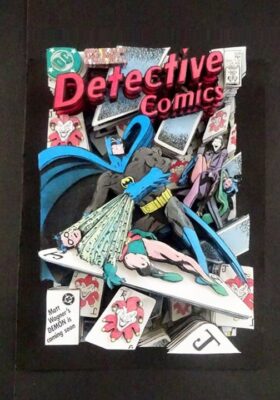
But yeah, it was a really exciting time, and I would have liked my comic career to have lasted longer. But there’s no way I would’ve traded the 21 years back then for the last 20, because things were just so much fun back then and so changing and a lot more freedom. I would say amazing the freedom, editors like Julie Schwartz had with characters like Superman and Batman and Green Lantern, but the changes did not have to be approved by corporate. Things just happened because an editor wanted them to happen, not because of a 10 year marketing strategy or something. Anyway, looking forward to talking to you more extensively later.
Alex Grand: Yeah, absolutely. Thank you Anthony. We love the historical perspective you bring and the fact that you’re a hybrid of comics and pulp history.
Anthony Tollin: And old-time radio.
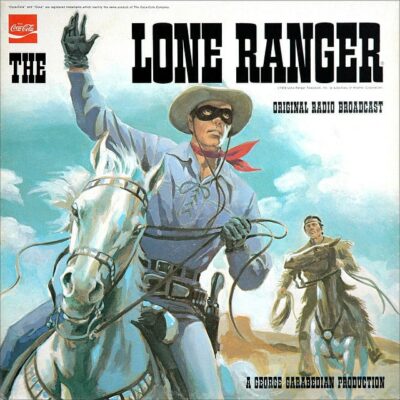
Alex Grand: And old-time radio as well. That’s true.
Anthony Tollin: One of the great religions experiences in my life was throwing a cue and having Fred Foy say, “A fiery horse with the speed of light, a cloud of dust, and a hearty Hi-yo, Silver!” I got to work with all of these wonderful Burgess Meredith,
Gale Storm, John Archer, who played The Shadow, all these wonderful old… Jackson Beck. But, okay.
Alex Grand: Well thanks so much. It’s been a real pleasure.
lex Grand: We’re talking to Whilce Portacio. Whilce, thank you for joining us.
Whilce Portacio: Hey, thank you.
Alex Grand: Whilce, tell the audience what were some of your childhood comic book artists inspirations growing up?
Whilce Portacio: During that time it was the big heavy influence still of the 60s guys. So I had like a trump of three.

Neal Adams at the time was coming in and so he was bringing illustrative stuff, so real anatomy and stuff like that, and I’m an anatomy freak, so I jumped on that stuff. And then, I got really, really got into Kirby, just for his imagination.
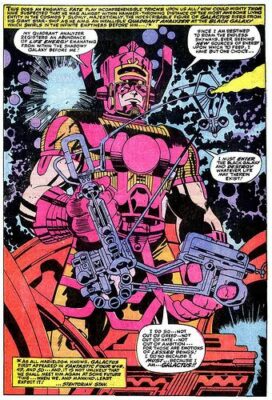
And then along the same lines, because I’m such a science fiction freak. Before comics, I started just devouring science fiction novels. Then I bumped into the artwork of Alex Niño, and he was pure sci-fi pure fantasy.
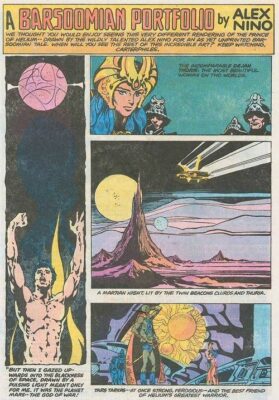
He was just, his hand would just go, and just create these weird worlds that you couldn’t right away understood, but then that made you look and look and look at his drawings more and more.
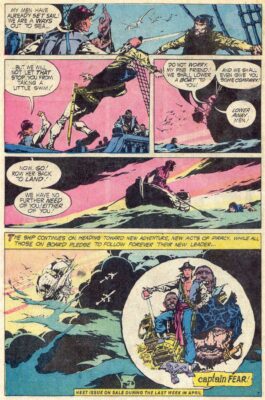
Alex Grand: So is that the DC and Warren stuff he used to do, in the seventies early eighties?
Whilce Portacio: Oh yeah. Oh yeah. And then also when Marvel started doing some of their black and whites. I remember being floored by Iron Fist with Rudy Nebres.

At that time, I don’t remember, he was doing some ink work and then he would put a gray wash on it, but he would do it in feathered, like he was inking, so it was like a double thing but with a nice contrast to it.
Alex Grand: He inked over Ditko too on the fly.
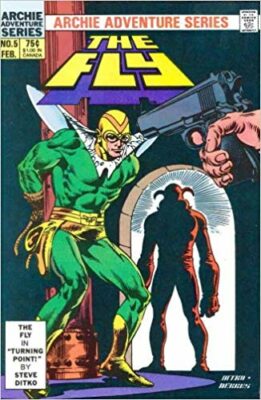
Whilce Portacio: Well a lot of those Filipino guys, they were just powerhouse work horses. They did almost anything and everything. You know, they could take chicken scratch and turn it into a full-fledged, fully rendered book, and you’d never know that it wasn’t. I think that’s why a lot of those guys were, the editors really needed these kind of guys, to get the job done, high quality work. Yeah. Yeah. Because the today’s standard, which has been a standard for a long time is a page a day, but those guys didn’t know that because as I found out talking with other people, before the Filipino guys came over here and worked for DC and Marvel, they were in the Philippines working for what was called komix with a K, and those were basically romance and horror stuff.

Well that standard was eight pages a week, penciled, inked and lettered by just the one guy. It’s a huge job. Yeah, it’s a huge job so when they came over here, again they were young artistic Turks that just wanted to prove themselves, so they didn’t know better they didn’t know to slow down.
Alex Grand: Yeah. That was the early seventies and there was a huge wave of artists, a huge wave.
Whilce Portacio: I was raised here, I’m 56 now, and I’ve been here since I was two years old. So I grew up absorbing this American culture, and I didn’t actually learn Tagalog, one of the Philippine languages until 10 years ago. My point is I was just fully absorbed in American culture, American art culture. So then when these guys came on the scene, it was a huge breath of air because it was totally different and then, because at the time a lot of the magazine work was just, was considered, “Okay, most people aren’t seeing that. That’s mostly a market for military servicemen,” and stuff, but the amount of work they did, the type of work they did, and effortlessly.
Alex Grand: A lot of them were inspired by Hal Foster. So they were putting in a high quality illustration.
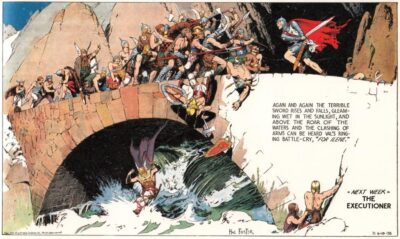
Whilce Portacio: High quality illustration. So growing up as an “American kid” and then slowly getting into my Filipino roots and then to find out that in the sixties and seventies you had this migration of these, this phenomenal talents and then they took reign for a couple of decades. And then I come on the scene and I don’t know any other Philippine artists, but then I slowly start finding some. And then I go back home to the Philippines and I set up a school there, and I discover Leinil Yu

and Philip Tan. And now you have Carlo you have Mico you have Jerome. So we have another wave. So it’s cool that I’m now part of a tradition… but it’s very interesting that here in the Philippines, thousands and thousands of miles away, not only do we speaking, almost everybody speaks English, but we totally understand American culture and American comics. So them coming over here there is no learning curve. It’s just give them a plot and go. And that’s the way it is with me but then I was raised here.
Alex Grand: Tell the audience how’d you get into the comic book industry? Around when that happened, how that happened.
Whilce Portacio: There was film connection too, because I’m a navy brat. So my dad retired in ’79. I was 16 I think at the time, so he wanted us, because we were raised in the States, he wanted us then to experience the Philippines. So we went back to the Philippines, and after three… two years in the high, finish high school, then I went to college. I went to an art college over there, and art over there was really great, but it was about abstract painting and I’m not really an abstract, I’m a realist. So I got out of college, came back here, had an auntie and cousins in San Diego. My older cousin drags me over and pulls my portfolio together and says, “We’re going to San Diego Con.” And I go, “What’s that?” This was way back. So this is when San Diego Comic-Con was in the Civic Center.
Alex Grand: What year was that?
Whilce Portacio: That must have been ’85 yeah. ’84 or ’85 yeah, so it was way over there, but knock on wood, I’ve been very, very lucky in my life. So that year, my first year, I don’t even know what San Diego Con is. My cousin drags me over, with my portfolio, and every single Marvel editor was there looking for talent. So I get caught up in that and boom. It’s interesting too because I originally as a kid, I grew up in the ’60s, so I wanted to be an astronaut but I’m too short. My kneecaps would blow if I ejected out of the ejector seats because there’s only one size and my legs are too short. Then I got, like I said I got into science fiction novels. So then because, that I wanted to become a movie director, before that could happen and I was really set in my ways there. My cousin comes in and drags me over, and as you know that was the beginning of a lot of this.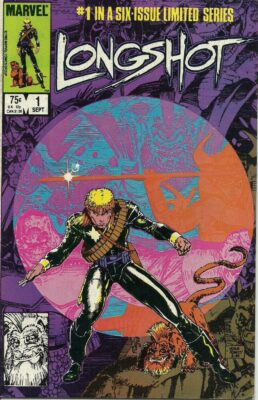
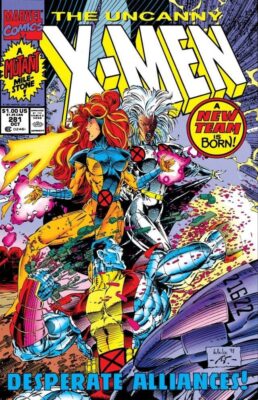
So in what I thought would be just this, “Okay, let me explore this pond for a little while.” More than 30 years later, I’m still here, stuck in this pond and it’s still going. It’s still going.
Alex Grand: Great professional lifestyle and you have a great body of work behind you and in front of you. So what projects are you working on now?
Whilce Portacio: I’m in a very, very lucky position right now where I can do covers. So I’m going to do one more year of covers, though I did an issue of Major X of Rob Liefeld a month ago.

Just test my squeaking bones and see if I could do a monthly book again, an issue again and, and I could. So, but I’m in the sweet position where for more than 30 years I did the page a day. I did interior work month-in and month-out, where you get to the point after five, ten years that, you have to go to conventions so fans will bring up comic books and remind you of your work because you do page one and then you go on, you do page 20 and then you clap, go to FedEx or now you scan it and send it over and the next day you start on page one.
Alex Grand: Right.
Whilce Portacio: So it becomes this blur after a while.
Alex Grand: A grind and a blur together.
Whilce Portacio: Yeah, and so the professional part of that is actually being able to effortlessly do storytelling and doing drawing that will appeal, but without thinking about it, because you only have four weeks. So when they started offering me last year to do covers, where I could take up to a week, a week to do one image and then just, and then really think about it and not just let my instincts go, but actually exercise part of that film director desire in me, because I’m quite fortunate that even though my dream initially was to become a film director, doing comics is much better.
Whilce Portacio: You hear all of the big guys, directors complain that at the end of the project they’re like dead-tired because every day they’re answering questions like, “So what color shoelace would the Hulk wear?” They have to make decisions on everything and everything and make sure everybody is in that field to hit the mood of the project, and day-by-day to scene-by-scene. Me, if I want it to rain it rains. I don’t have to call up the fire department. I don’t have to ask accounting, “How much is 400 gallons of water going to cost me?” If I see a pretty girl on the street, she’s in the book. I get to exercise all of the artistic skill that a movie director does in casting, in acting, what directing the actors to act the way he wants, in deciding on production design for locations and everything, deciding the pace, deciding the choreography and everything. I can do that, but I can do it in a Godlike way where, if I want it to happen it just happens.
Alex Grand: That’s a great description. So the vision is implemented right away, right there.
Whilce Portacio: It’s all just up to me. Whatever I can do, and that’s why I believe every genre, every field has to have their place. So for me what comics is, is if I can imagine, I can draw it. There’s no consideration of budget. There’s no consideration of, “Do we have fabricators that can do this? Or can we do this CG?” Right? It’s just up to me. So I believe almost all our stories should be epic. Should be as big as our imagination of the concept can be. Never tempered by any real world consideration.
Alex Grand: Like a Cecil B. DeMille movie, right?

Whilce Portacio: Yes, exactly. Exactly. And then in the inter-industry vein, we should be thinking, “Hey, is this story a story that… ” okay, Hollywood can do everything now, “but are they going to have a tough time doing this? Or are they going to need a 500 million budget to do this?” I think we should do that, because that then pushes the boundary of story and concepts, instead of trying to keep it in the realm of can we do this? Because again, if you ask that question, can we do it? Well it’s, can I do it? And most of us guys in the top level, we can do anything. That’s what the skill set is, you know? And so I think all our stories should be that way.
Whilce Portacio: I think, again because I’m a science fiction guy, yeah, everything based in some kind of reality or some kind of science in you keeping it strong, adherence and discipline to the rules that you’ve set, but let yourself go. There’s so much that still hasn’t been imagined. Imagination comes from limitations, from the unknown, and then us artists going, “Okay, maybe this explains that or maybe this is what’s really happening.” It’s fantasy, it’s conjecture but the non-creative people they don’t have the time to think about that.
Whilce Portacio: It’s life. I really am proud that I could take my field back to way, way, way back, Leonardo DaVinci and everybody, they did comics, but the definition of comics back then was, a lot of those guys back, the classical guys did like the Gods, the Greek Gods and stuff.
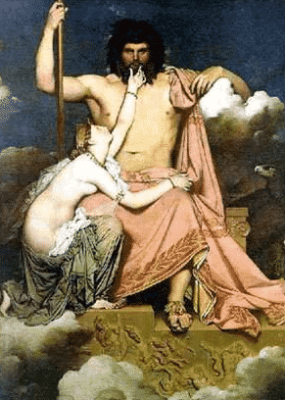
Well they couldn’t call Zeus and say, “Zeus, can you pose for me for a little while?” So they had to imagine that and then reading the stories of Waterhouse going to Egypt and then measuring what remained of the pyramids and stuff, and then copying down all the hieroglyphics so that he could get exactly.
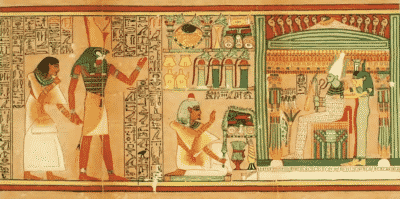
So he was doing the same thing. He was taking mythos, a script, a plot, a fantastic one, and then trying to imagine it with his realistic style, imagine it for regular people, what it might have looked like, and hopefully from there inspire. And you take it even further where everybody back in the, way, way, way, stone age days or the medieval days, life was just too much. You didn’t have supermarkets or anything. You had to not only be able to hunt down your food, find food, process it, skin it, know what not to eat and then know what to do with the organs and stuff and then know how to cook it and know how to find salt if you’re lucky. Back then, almost everybody, 90% of the people I believe, had life to concentrate on.
Whilce Portacio: So when I come along and I’m too cowardly to fight any of the wars, because I don’t want to get killed or my back won’t be able to take the work of farming or anything like that. And so I’m just walking around and I bump into these guys dead-tired, six o’clock at night eating their dinner and I come in with this fantastic story of what if a lord and his knights were benevolent? Which is what they’re thinking, because everybody’s bad but what if there were these powerful people who were good? So I’m telling them this fantastic historic King Arthur, and it sticks because it’s not what they could imagine, but it’s what they hope could happen. You know?
Whilce Portacio: So us storytellers, us creative people, we’ve got a really long lineage and I don’t think we hark on that enough. We are really at the roots of society’s inspiration, society’s explaining what life is, what phenomena is. Is the sun going to come back? What is the sun? Again, most people don’t have any time to deal with that. They just, “Oh great, I have food now,” and, “Hey, that guy is coming.” Or, “Is that guy going to come around again? He could tell these weird stories. I don’t believe in them, but oh it’s fun listening to this stuff.” You know? And then okay hey, they offer me a little corner in the shed or in the barn and they give me some food. I can’t farm, I can’t hunt and so that cycle works itself and I think that happened throughout our history.
Alex Grand: I like that. So imagination, inspiration, hope and bringing that to people to enjoy. Whilce Portacio, thanks so much for joining us today. We really appreciate the talk.
Whilce Portacio: Oh, thank you. Thank you. This is fun and it’s great you guys are digital now. In the old days when it was taped I would always run out all their tapes so…
Alex Grand: And we love your passion. Really. Thank you.
Whilce Portacio: Thank you.
Alex Grand: Well we’re here continuing our journey at San Diego Comic-Con 2019. I’m talking to one of my comic book artist idols, Jimmie Robinson. How’re you doing?
Jimmie Robinson: I’m doing just great. Right on.
Alex Grand: Well Jimmie, I love your comics. I’m a big fan of your Bomb Queen series. Tell us about your childhood comic book influences. Who are the artists that you looked up to?
Jimmie Robinson: Oh, I looked up to Neal Adams.

I love a lot of his stuff and a lot of early DC work. I remember I didn’t get into comics until late teens though, but that’s when I had somebody in the, a comic retailer helping my mom out who would then send books to me with little Post-its on it saying, “Check this out.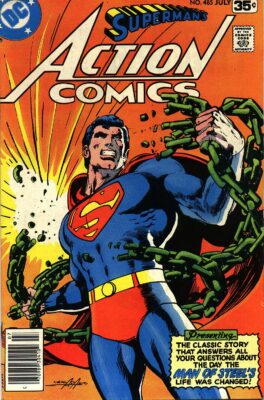
Look at this inking. Look at this penciling. Look at this layout.” And that helped influence me a lot. And I never to this day met that guy. He would only give stuff to my mom and then she gave me the comic books from this comic book angel or whatever. That was cool and yeah, a lot of early influences, even way back to like G.I. Combat and stuff like that
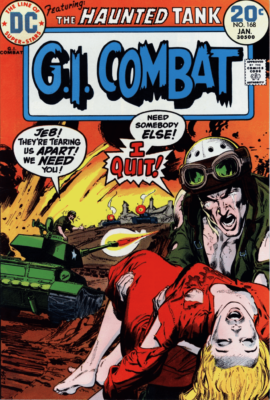
, and The Haunted Tank and whatnot and some EC comics.
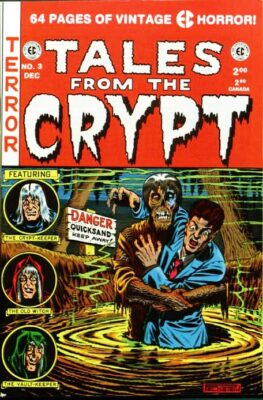
It was just like, I didn’t do the whole 7-Eleven spinner rack thing or back when they had that, but there was always something in there that I liked, but I always tend to go to some of the weird angles and that influenced me a lot. That was a lot of fun.
Alex Grand: So it was almost like morbid, and not necessarily superhero but other genres to war, horror, whatever else?
Jimmie Robinson: Right, right, and that’s where I didn’t become like a superhero head kind of a guy. I did love them a lot, but it wasn’t my only focus. I was a Batman guy, I was a Superman guy or I was a X-Men guy
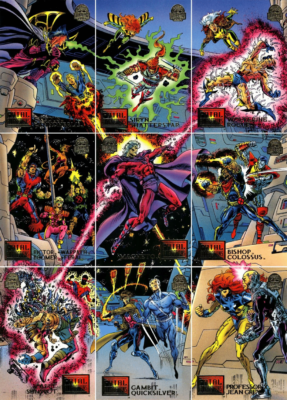
or whatever, or an iron man guy, whatever it just, it was a part of my range that hit me. And so when I started my own comics, I didn’t really have that style. I came to San Diego Comic-Con my first year was 1994, ’93, ’94 and I came right up to the door with my portfolio and I was so chicken, I didn’t even come in the doors. I came all the way to San Diego and never went in, because I was so scared because my style didn’t match anything. It didn’t have the Marvel style at the time or the DC style at the time because my early influences weren’t so focused. So I didn’t know how to draw a Spider-Man.
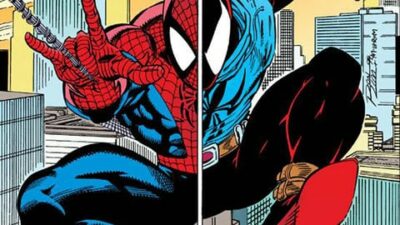
I didn’t know how to do all the characters that they did. That just really opened my eyes to a new thing, so I just started self-publishing and it was just a wild ride that way, and yeah, yeah, that’s where I am.
Alex Grand: So tell us about self publishing and then getting into Image?
Jimmie Robinson: Yeah, self-publishing I did because like I said, I came here and then chickened out, so then I got my act together and I said, “Well I’ll just do my own book, I won’t come in here and try to find a job with my style… ”
Alex Grand: And what year was that?
Jimmie Robinson: Like I said ’94, but then doing my own stuff was in ’95 going into ’96. And I started self-publishing, I did a book called Cyberzone.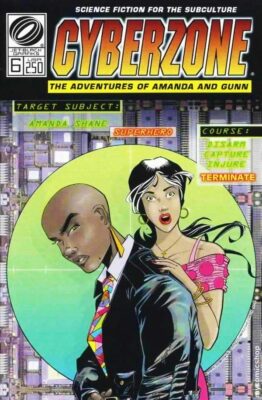
Alex Grand: And tell a story.
Jimmie Robinson: And tell a story, exactly. And then at a certain point I just, in a hubris of mine just announced to the industry, “Well, I’m going to stop doing this. It was a bit of fun and all that but I don’t think anyone’s really, whatever, I’m going to try and do something else,” and unbeknownst to me, a lot of people were watching and I didn’t even know. And one of those people was Image, and three days after I made that announcement, Jim Valentino at Image said, “Dude, what? Come over here.” He was like, “Dude, were you going to stop? Don’t stop. Just come over here.”
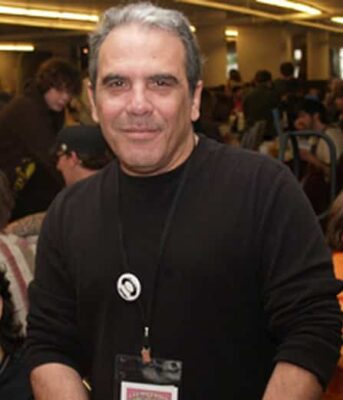
So I literally took the same characters that I was self-publishing, and Cyberzone, and that was my first Image book called Amanda and Gunn.
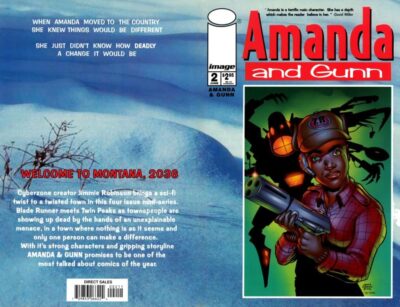
Ever since then I’ve been with Image. It’s been over 20 years, so, and that led up to Bob Wayne.
Alex Grand: Yeah, I guess I could see Jim Valentino, his art style and yours, there’s almost like it’s like cartoon, but not, but it’s also, it’s a combined approach. So he probably felt a kinship with your artwork.
Jimmie Robinson: Yeah, Valentino, he’s the vice president of Image comics, he’s one of the founders of Image comics and in the late nineties he was actually the publisher, like the Eric Stevenson up today. He was actually the curator of all this content, and Valentino is an indie guy, he’s an underground guy.

And he did Guardians of the Galaxy and all that stuff,

but he’s also a big indie guy and he wanted to really create a new content, not just the superhero content. As a matter of fact, he had a thing called the non-line back in the day, which was strictly no superheroes, black and white books and that was the only time I was on the cover of previews, but yeah he really went out of the way and God bless that guy. He really, to this day still, tries to push the envelope in his own way. And a lot of companies now are doing the same thing, and he was one of the earlier people to do it. Valentino, he’s the one that green-lit Bomb Queen off of just a couple of pictures that I drew. He’s like, “What’s this?”
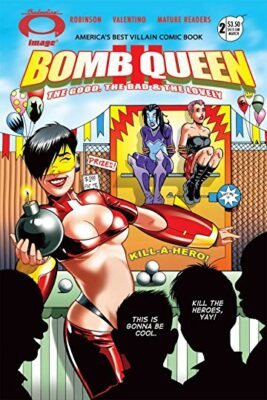
Alex Grand: And it was unique for sure.
Jimmie Robinson: It was unique to him and I’m like, “Well, I don’t know if you’ll want it Jim, it’s different. It’s not like a superhero book. It’s a super villain book. It’s the bad guys that win all the time.” And he’s like, “I like it. Show me more.” And then after that, it was initially just a four-issue series, a four-issue mini series and now, yeah, we’ve got like…
Alex Grand: It’s a huge success and I love it. Now what projects are you working on now?
Jimmie Robinson: Right now I’m working on new Bomb Queen, Bomb Queen vs. Trump and-
Alex Grand: And you had done a Bomb Queen vs. Obama, and you also, so you’ve got on three presidents basically.
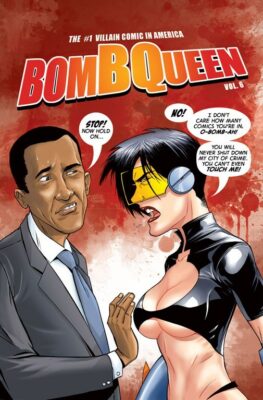
Jimmie Robinson: Yeah. Bush, when the Iraq war thing and Halliburton and all that stuff and everything. And then Obama, because Obama would not stand for a Bomb Queen on U.S. soil.
Alex Grand: And now Trump is the next target.
Jimmie Robinson: Yeah. It’s going to be weird saying target because Bomb Queen and Trump are the same, they’re buddies really. So the whole thing will be how-
Alex Grand: Oh that’s really interesting.
Jimmie Robinson: Yeah so the whole thing is getting to a point in the Trump presidency where the superheroes of the country come to Bomb Queen for help because she’s the only one that could capture his base-
Alex Grand: And maybe think like him in a way you’re saying.
Jimmie Robinson: … and think like him because you’re not going to beat Trump by saying he’s a bad guy, because nobody cares about that, he’s a… Yeah, he’s got his base that says they love it. Just like Bomb Queen has her base that says, “We love how evil she is.” So the only way you’re going to beat Trump is to steal his base from him and that is to out-Trump Trump. Not to be a good guy, but to be a bad guy.
Alex Grand: I like your style.
Jimmie Robinson: Yeah and the ultimate bad guy is a bad girl. That’s Bomb Queen. So yeah, so that’s, so the heroes get together because they can’t kill their own sitting president. There’ll be villains. So you get a villain to do your dirty work, but of course it’s Bomb Queen and she’s going to win where everyone’s probably going to get stabbed in the back kind of a thing. So you’re making a deal with the devil. You’re going to pay the price.
Alex Grand: You’ve created a tremendous character and wonderful work, Jimmie. Thanks so much for talking with us today.
Jimmie Robinson: I love this. You guys are great.
Alex Grand: Benton Jew. Benton, how’re you doing?
Benton Jew: Hi. How are you? Good to see you, good to be here.
Alex Grand: Benton, tell us about your childhood influences of comic books before you got into the business.
Benton Jew: I guess when I was growing up, I would spend a lot of time at my grandmother’s house and I would look at all my uncles comics, and those comics went back to the forties. As a kid growing up in the ’70s, it was great to see influences flowing back to Zorro

things like that. Or at that time the more modern stuff like Dave Cockrum doing Legion of Super-Heroes or
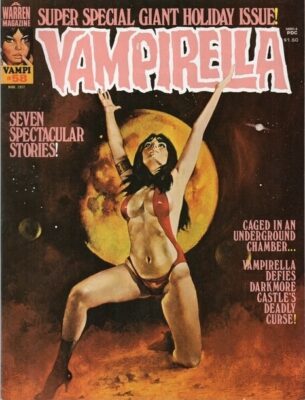
Alex Grand: Yeah. So it sounds like you liked pretty much any country, any genre, as long as the comic art was good?
Benton Jew: Yeah. Basically art was the thing. I started drawing at a very young age, and my mom learned how to draw, she was an art student, so she gave us all her art books when she decided to give up art and become a teacher. So we grew up on Andrew Loomis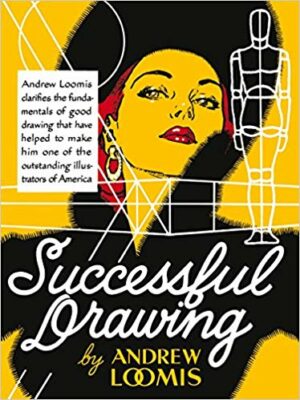
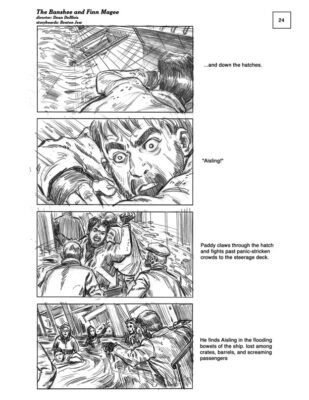
Alex Grand: So that’s interesting. So storyboarding and comics, that’s a visual storytelling basically. Now when did you figure out you had a knack for that?
Benton Jew: Pretty early on. I guess by the time I was in first grade I was already selling pieces of art. “Hey, draw Superman having sex with Wonder Woman.” So, “Okay, there’s your nickel,” Okay, so…
Alex Grand: Like a Tijuana Bible or something.

Benton Jew: That’s how kids learn how to draw I guess, starting from that, but…
Alex Grand: Sweet adolescence. So now what got you into the comic business? How’d you get in?
Benton Jew: Actually I always wanted to be a comic book artist, but also the movies were on the side because I just wanted to draw comics, but then by the time art school came around, I was able to get a job working in Industrial Light & Magic doing storyboards. Probably because my portfolio had some complex style stuff in it and one of the people who recommended me is a big fan of old style comics. And my artwork tends to be kind of in an old, old style. I showed it to the storyboard artist for Indiana Jones and he was a big fan of Stan Drake and Leonard Starr
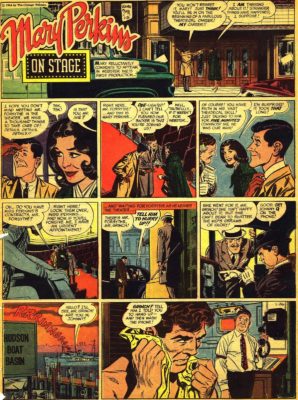
, “Your style kind of looks like that.” And so he remembered me and then years later he said, “Well I have this job,” that ILM wanted him to do, but he couldn’t do it so he said, “Yeah, you guys get some guy who draws that don’t sell comics,” and that’s how I got into working at ILM.
Alex Grand: Now tell us some of the projects you’ve done for various comic companies like Marvel and some of the independents.
Benton Jew: I did some stuff for COMICSWORKS.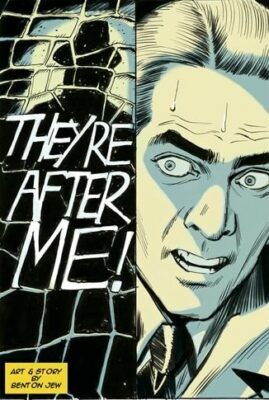
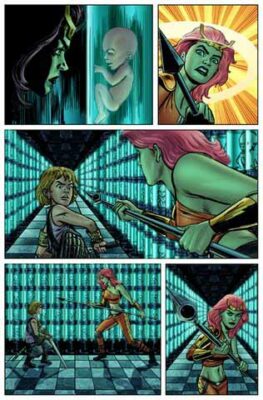
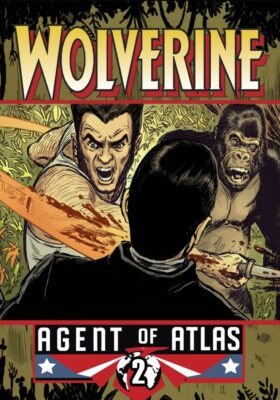
Alex Grand: So what projects are you working on now?
Benton Jew: I’m working on mostly storyboarding movies.
Alex Grand: That’s your bread and butter, basically.
Benton Jew: That’s my bread and butter, yeah. The next thing that I think that’s big that will be coming out will be the new Mulan movie I worked on, the Mulan movie and things like that. So I ended up working on a lot of superhero movies. Yeah, I’ve worked on Wonder Woman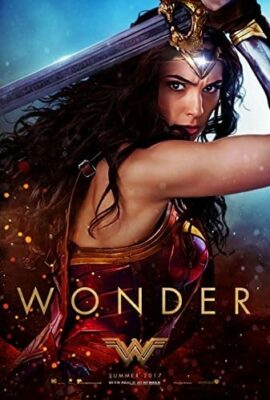
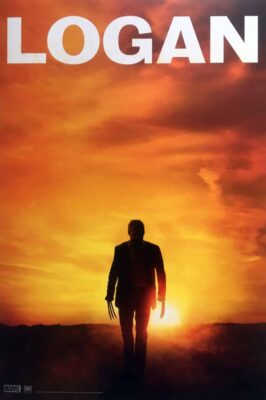

Alex Grand: Well, that sounds great. Well, Benton, thank you so much for the interview today and we wish you a great Con.
Benton Jew: You too. Thanks a lot.
Alex Grand: Today we have Jim Cheung, which we’re really grateful to be interviewing. Jim, how’re you doing?
Jim Cheung: Great. Thanks for inviting me.
Alex Grand: Jim, tell the audience about your childhood comic book influences. You’ve done a lot of work for both Marvel and DC. What kind of comics did you read as a kid?
Jim Cheung: I read pretty much everything I could get my hands on I think. I started up reading Marvel books, but then I discovered all the DC stuff, but at the time I pretty much grabbed everything I could off the shelves.
Alex Grand: Did you read also things other than Marvel or DC, like Warren magazines and things like that, or was it mostly superhero stuff?
Jim Cheung: It was mostly superhero stuff because that’s what I could get my hands on, because I grew up in the UK, so all the Warrens stuff wasn’t really available to me at the time.
Alex Grand: Oh yeah. I see. Yeah. So then with the superhero stuff, were you more of a Marvel guy or DC guy, or maybe just you just liked it all?
Jim Cheung: Because I’m currently working with DC, I would say I’m pretty neutral, but Spider-Man is my favorite.
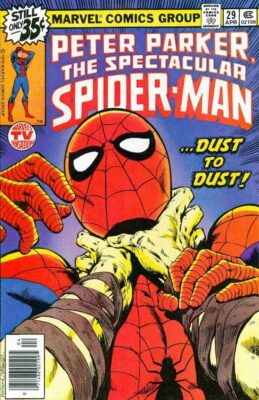
Alex Grand: There you go. So now who are artists that you looked at and were inspired by when you were reading those comics?
Jim Cheung: I loved John Byrne growing up.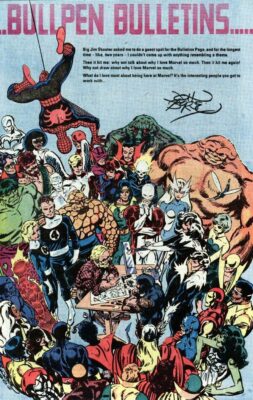
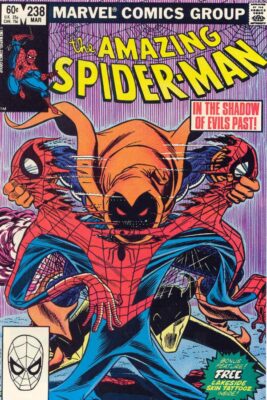
and all those guys from that period I think. I used to be able to just pick up a Marvel book or DC book and because I spent so much time looking at them, I would be able to tell who drew what instantly.
Alex Grand: Like in ’80s, you were pretty much doing all this. So reading those comics in the ’80s then?
Jim Cheung: Absolutely, yeah that’s how old I am. Yeah, yeah, yeah.
Alex Grand: So then how did you get into the comic book business?
Jim Cheung: I just almost fell into it. I knew how to get into the business, so I just produced samples like they told us to and luckily enough it got put in front of the right people and from there it just kind of just went from there. Yeah.
Alex Grand: Around what year was that when you entered the comic book business?
Jim Cheung: Oh boy. It was the mid-nineties. Yeah.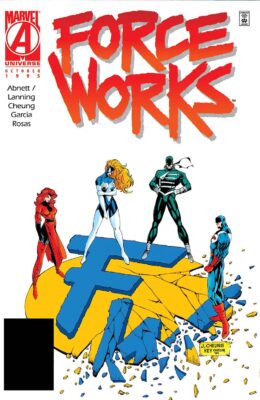
Alex Grand: Tell the audience what stories you did for Marvel, and then also what projects you’re working on for DC now?
Jim Cheung: For Marvel, I’ve done pretty much everything, I started off doing like the Teen Tony Stark story
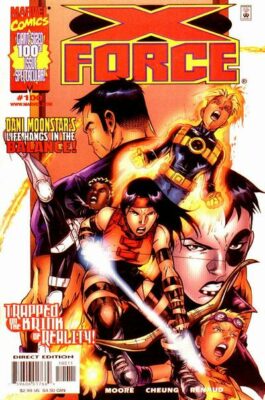
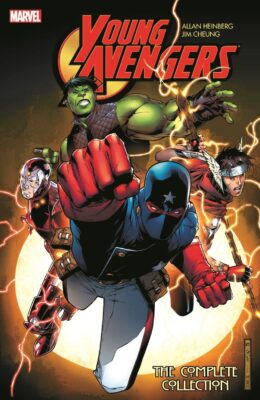
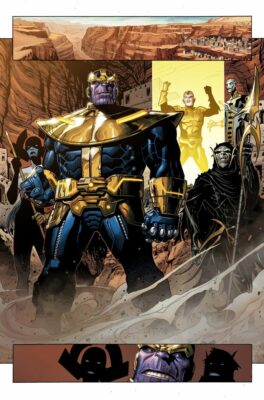
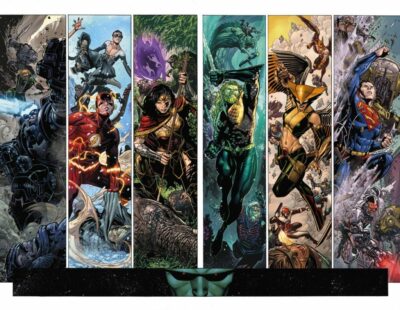
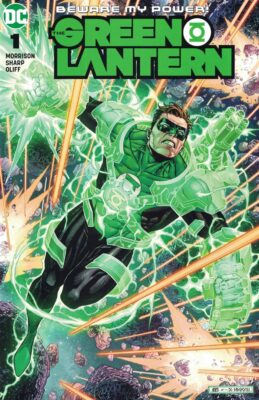
Alex Grand: Well I love what you did with Justice League. That is really beautiful work. I think a lot of people, when they see those pages, they’re just blown away.
Jim Cheung: Thanks very much, yeah, put a lot of effort and time into it and I really wanted to make an impact on my first introduction to those characters, so yeah, but it’s been fun.
Alex Grand: And I also noticed you have no problem doing team books. You can pretty much just draw everybody on that page. Is that daunting at first and then you’re just used it or was that pretty easy from day one?
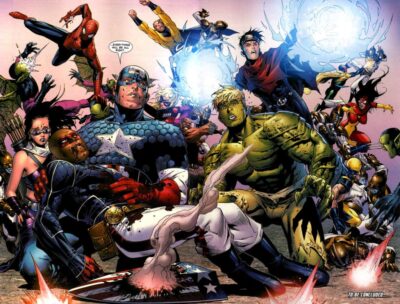
Jim Cheung: I think I just got used to it, just from over the years. They just kept adding more characters. And really when you’re doing a solo character, it’s not really a solo character, but because there’s always so many background characters. So I just got used to juggling characters on the page, so yes, it’s second nature now.
Alex Grand: Well, we’re really grateful for the discussion today. Thanks so much for joining us.
Jim Cheung: Thanks very much.
Alex Grand: Hope you enjoyed the show folks. We’ll be back next time with my co-host Jim to get deep into the annals of comic history. Cheers.
© 2020 Comic Book Historians
